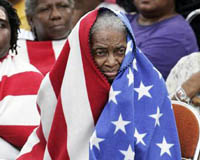U.S. Poverty Rate Impresses

U.S. Poverty Rate Impresses
The National Academy of Science revised poverty rate. The numbers seem to be quite unpleasant.The Officials are in search for the problem solution.Thus the poverty rate among older Americans could be nearly twice as high as the traditional 10% level, accordinghe National Academy of Science revised poverty rate. The numbers seem to be quite unpleasant.The Officials are in search for the problem solution.Thus the poverty rate among older Americans could be nearly twice as high as the traditional 10% level, according to a revision of a half-century-old formula for calculating medical costs and geographic variations in the cost of living.The Nationa to a revision of a half-century-old formula for calculating medical costs and geographic variations in the cost of living.The National Academy of Science's formula, which is gaining credibility with public officials including some in the Obama administration, would put the poverty rate for Americans 65 and over at 18.6%, or 6.8 million people, compared with 9.7%, or 3.6 million people, under the existing measure. The original government formula, created in 1955, doesn't take account of rising costs of medical care and other factors.If the academy's formula is adopted, a more refined picture of American poverty could emerge that would capture everyday costs of necessities besides just food. The result could upend long-standing notions of those in greatest need and lead eventually to shifts in how billions of federal dollars for the poor are distributed for health, housing, nutrition and child-care benefits.The overall official poverty rate would increase, from 12.5% to 15.3%, for a total of 45.7 million people, according to rough calculations by the Census Bureau. Data on all segments, not only the elderly, would be affected:• The rate for children under 18 in poverty would decline slightly, to 17.9%.• Single mothers and their children, who disproportionately receive food stamps, would see declines in the rates of poverty because noncash aid would be taken into account. Low-income people who are working could see increases in poverty rates, a reflection of transportation and child-care costs.• Cities with higher costs of living, such as New York, Chicago and San Francisco, would see higher poverty rates, while more rural areas in the Midwest and South might see declines.• The rate for extreme poverty, defined as income falling below 50% of the poverty line, would decrease due to housing and other noncash benefits.• Immigrant poverty rates would go up, due to transportation costs and lower participation in government aid programs.The changes have been discussed quietly for years in academic circles, and both Democrats and Republicans agree that the decades-old White House formula, which is based on a 1955 cost of an emergency food diet, is outdated.The current calculation sets the poverty level at three times the annual cost of groceries. For a family of four that is $21,203. That calculation does not factor in rising medical, transportation, child care and housing expenses or geographical variations in living costs. Nor does the current formula consider noncash aid when calculating income, despite the recent expansion of food stamps and tax credits in the federal economic stimulus and other government programs. The result: The poverty rate has varied little from its current 12.5%.Next week, the Census Bureau will publish official poverty figures for 2008 with a cautionary note about the shortcomings. The agency says it will expedite release of alternative numbers in the following weeks, because of the interest expressed by lawmakers and the Obama administration in seeing a fuller range of numbers."The current poverty measure does a very bad job of measuring the impact of quite a few of our anti-poverty policies," Rebecca Blank, the Commerce Department's undersecretary of economic affairs, said in an interview. "It isn't meaningless, but it isn't complete."Although the White House Office of Management and Budget dictates how federal poverty is measured, legislation pending in Congress would require use of the National Academy approach. Advocates are hoping the White House may act on its own, USA Today reports.

